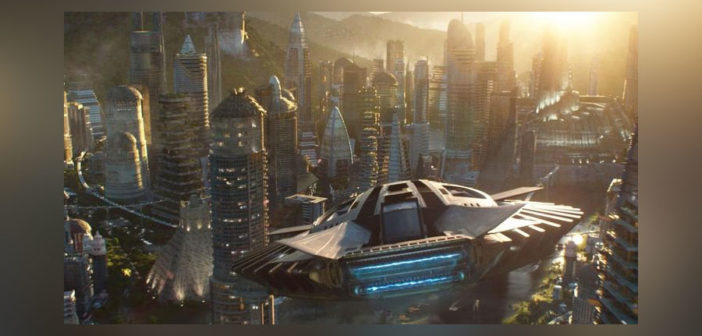Here’s how Hannah Beachler, the design force behind Moonlight and Lemonade, shaped the movie’s set design.
Read any review of Black Panther, and you’ll see kudos for Chadwick Boseman’s T’Challa, the convincing philosopher king. You’ll spot poorly masked crushes on Michael B. Jordan’s Killmonger, the charismatic antagonist. And you’ll see fealty sworn to Danai Gurira, Lupita Nyong’o, and Letitia Wright–the film’s rightful, albeit unofficial, queens.
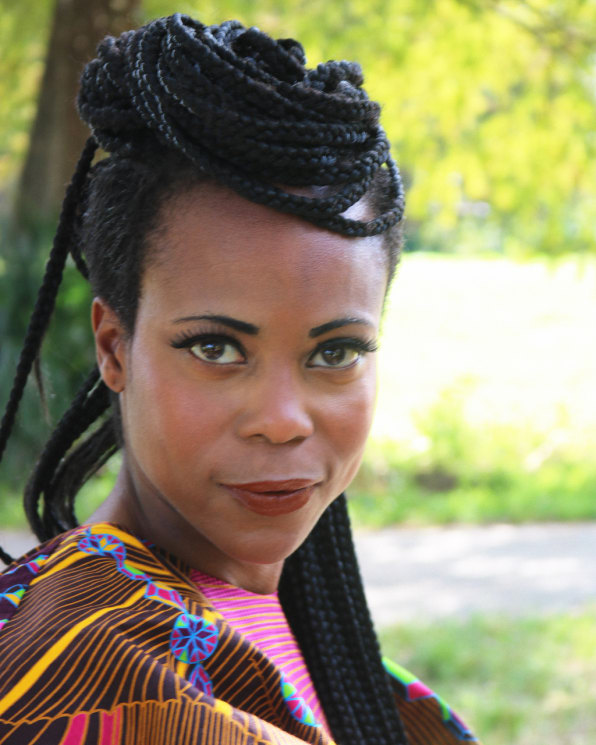
But the character who steals the limelight is not an actor at all. It’s the setting, or mise-en-scène if you want to be formal about it: Wakanda. Wakanda is a fictional, hidden country in Africa that’s never been colonized or conquered because it’s sitting on a mass of magical metal that’s transformed the nation into a technological wonder that’s literally invisible to the outside world. It’s impossible not to be smitten with Wakanda’s Golden City, an homage to Afrofuturism that seems to ebb and flow like the landscape itself.In an exclusive interview with Co.Design, the New Orleans-based production designer Hannah Beachler, whose credits include Moonlight, Fruitvale Station, Creed, and Beyonce’s Lemonade, broke down how she articulated a Wakanda that none of us have ever seen.
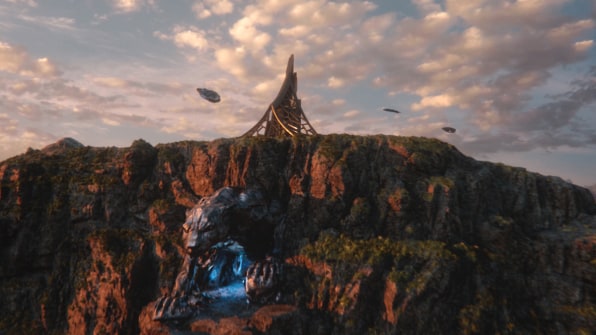
THE BID TO BUILD WAKANDA
It’s hard to believe, given Beachler’s impressive credentials, that she wasn’t a shoo-in for the job. While she had worked with director Ryan Coogler in the past on both Fruitvale Station and Creed, that history alone wasn’t enough to convince a mega business like Marvel/Disney that she was ready for a big-budget film. Creed had cost roughly $30 million to make. Black Panther was a $200 million production.”Ryan had said, ‘Yeah, I want to bring my production designer, Hannah,” she recalls. “They’re like, ‘okay,’ offering a sort of courtesy conversation that we could have. They were going for big fish because this is a big project.”
“I remember when my agent was like, ‘go and talk to them and present’ and I said, ‘am I gonna get the script?’ Beachler continues. “They’re like, ‘no, you don’t get any information.’ That’s when I started sweating, I was like, ‘Oh lord, what am I gonna do?’”
“Then I remembered years ago when I first started noticing Zaha Hadid. I’d always loved her work,” says Beachler. “She was the first person who popped into my head.”
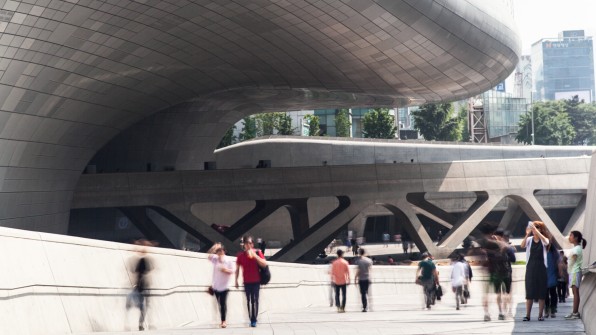
Specifically, it was projects like Hadid’s DDP Building in Seoul, the MAXXI museum in Rome, and Wangjing SOHO in Beijing that left their mark on Beachler’s psyche.
It wasn’t just Hadid’s modernist curves, though, that seem to defy physics and scream “The Future!” to the eye. It was the way she architected interiors, too. “Her buildings are all of large scale, but, here’s the thing: When you walk into them, you have this feeling of intimacy, right? Her buildings are far and away the biggest thing I’ve been in. They are just sprawling and ginormous, but, because of the curves, and the voluptuous nature of her designs, you have this intimate experience,” Beachler says. “And it’s the juxtaposition of these two scales you think will never happen together.”

“I knew that that was something I wanted to bring to Panther, to have these intimate spaces,” Beachler continues. “She does it by little tricks, like the way her stairwells use a lot of curves, or by using a lot of wood inside a space made of metal and drywall plaster. But the other thing that she does, and is the big main trick that I did a lot, is that she brings her ceiling down. So, when you’re in this enormous space, you don’t have a 50- or 60-foot ceiling to make you feel like you’re not connected in a way. The ceiling comes down 20 feet, maybe 30 feet. That makes a huge difference.”
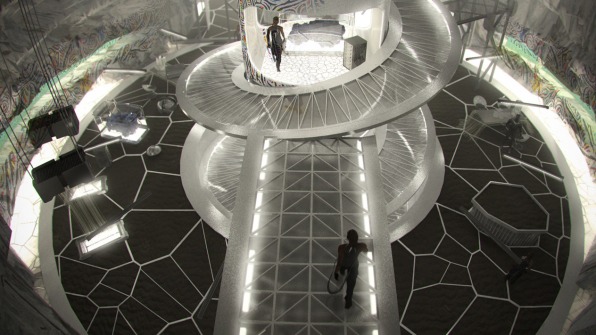
Coogler is not a director known for his expansive, wide-shot adventure epics. He’s celebrated for a fast-paced, intimate style, focused on only one or two characters sharing a moment in their lives. He gives the viewer an opportunity to be the third wheel in close-quartered, casually revealing scenes, and Hadid offered Coogler a way to showcase his uniqueness as a director inside a film with the impossible scale of Black Panther. He could have his grand Golden City of the future and his subtler moments, too. Even the scenes set in the film’s techno wizard science lab seem less clinical than personal, thanks in part to the low ceilings, walls that look like a hybrid of tree bark and stone, winding stairs, and other architectural elements at play.
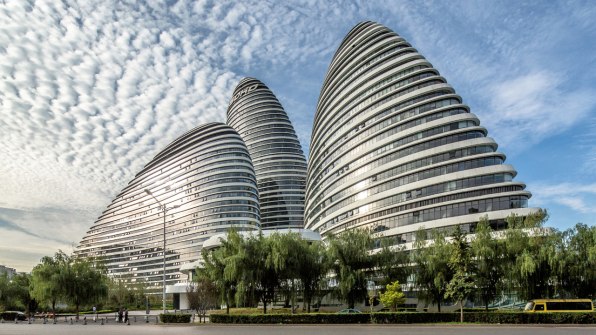
The other benefit of using Hadid’s buildings as an inspiration was that they feel organic–and even biomimetic. That was important, given that one of Black Panther‘s main themes is tradition versus innovation. Wakanda embodies both, by embracing nature and technology.“You could pick up some of her buildings and stick them in a rainforest or stick them on the mountains and it feels natural to that because of the peaks and curves and the way her buildings are,” says Beachler. “That’s another thing I wanted for Wakanda. I didn’t want to be like, ‘Here’s this giant great awesome Dubai-city!’ So of course you have to have a hologram to hide it. I wanted it to feel like you just come upon another part of the Earth when you fly through the hologram, and you first see Golden City. I wanted it to be awe-inspiring and majestic, but not like, ‘Oh that’s New York. That’s Manhattan.’ It needed to feel like a piece of the nature.”
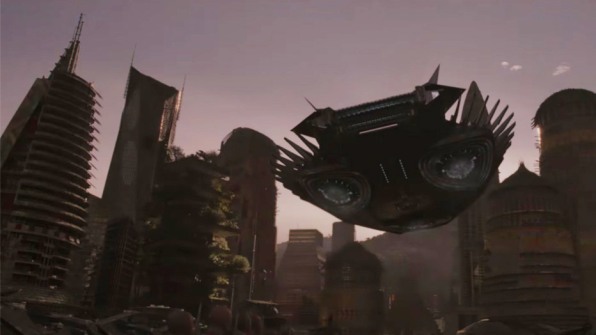
But while Hadid’s aesthetic made sense in its organic use of scale, modern architecture is almost the antithesis of what Wakanda needed to capture, isn’t it? After all, modernism is essentially culturally agnostic, with shapes and forms borne from no discernible heritage. And Wakanda had to be African through and through–a fabled, unconquered nation that could embody the history and potential of the Pan-African ideal of unifying 54 real countries across the continent under one flag.
“That’s what Wakanda is,” says Beachler. “It’s all the cultures that came together while they’re still individual. They have found a way to combine their aesthetic to create a Wakanda aesthetic.”
So, to bring Africa to Hadid, Beachler looked at historical sites, like the Mali Pyramids, intermixing them with Africa’s existing architecture to create that Golden City skyline.
This approach would win her the job–and later, she’d pay homage to Hadid herself by making her own pilgrimage to the DDP building. “After I had gotten the job, I walked into the building, and knew I was a mess. I’m in tears, I’m crying at this point because she had passed away that summer before,” Beachler says. “The world had just lost a genius.”
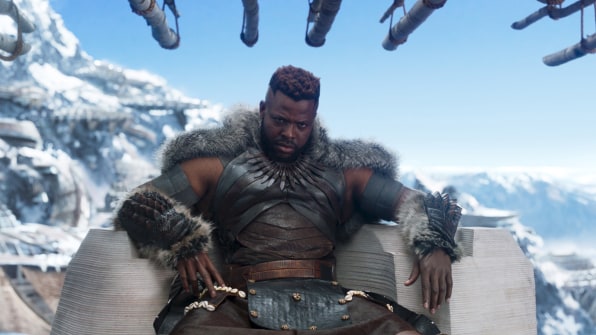
WRITING WAKANDA’S HISTORY
The pitch was only the beginning, though. Beachler had to create a complete film’s worth of sets, so she took a long visit to Africa and spent months in deep research. All of this would culminate in Beachler’s 515-page “Wakanda Bible” that encapsulated everything about the world.
“Ryan needed to know where he was putting the story, and I need to be able to be a part of giving him that. Because at the end of the day, it’s about the story,” says Beacher. “He’s an Oakland guy, so when we did Fruitvale, Oakland was such an important piece of that story. Then Philly was such an important piece of the story in Creed. And Wakanda is no different. We just had to create that history ourselves.”
Beachler knows the history of Wakanda inside and out. To hear her talk through a single set is like reading annotated Shakespeare. You thought all the filigree was beautiful, sure, but then you realize that there is a whole undercurrent of allusion and significance, countless hours of intellectual effort that might be on screen for 30 seconds.
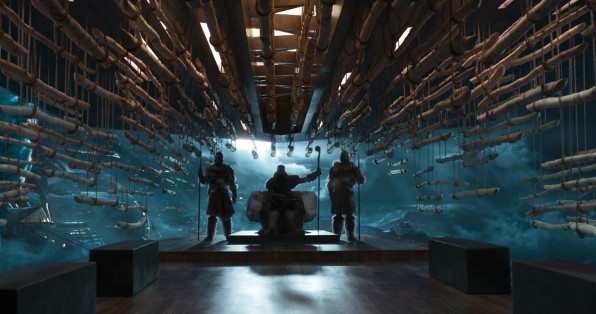
Let’s look at one set that Beachler had attempted to annotate on Twitter, before realizing that character counts and set designs don’t mix. It’s M’Baku’s throne room. He’s a mountain-dwelling king who resides just outside the techno-infused Golden City. He sits on a throne with a backdrop of clouds and pure air. And inside this room, birch logs seem to float in space, like ghosts lured by the sheer power of his royalty.
The setting is chilling, even if the viewer doesn’t know the story behind the birch. “It grows in the north, it grows in the cold because they’re in the mountains. So, of course it would be birch,” Beachler explains. “And then the story behind birch is, that is what Native Americans gave to the first [European] settlers when they came as a sort of peace offering, because birch is a wood that symbolizes ancient wisdom and it also symbolizes truth.”
I'm gonna share a couple pics I snapped of the sets, M'Baku's throne room, T'Challa's office and Hall of Kings in Necropolis. Proud of the hard work this team put in to everything we did. #BlackPanther #chinchilla1970 #productiondesign pic.twitter.com/aGB5h5YE9q
— Hannah Beachler (@chinchilla1970) February 21, 2018
Wisdom and truth seem perfect for an ancient throne room. But the birch also harkens back to the hypocrisy of white settlers across the world, who turned on the welcomers. It tacitly links the plights of Native Americans and Africans. Then, atop all of this, Beachler tacks on another, subliminal kicker. Look closer, and you’ll see that Wakanda isn’t using the birch to make a peace offering to anyone.
“We sharpened the birch at the end–weaponizing that truth,” she says. “It’s about weaponizing and protecting yourself, and protecting your ancestry and your ancient history from those who come to take it. So, instead of just giving these logs, these beautiful paper-like logs, with a paper-like bark to someone, then all of a sudden, it’s a weapon, in a sense.”
“That was one thing,” she laughs. “There were 300.”
A skeptic might say that Hollywood’s best production designers, like Beachler, are overthinking their work just a bit. There are countless allusions in Black Panther that are never articulated to the audience. Even still, that world history is essential for Beachler to produce an authentic story, as fictional as it may be. And while it might be futile to even attempt to unpack all of the significance hiding in Black Panther‘s production design, Beachler is thrilled to see her work sparking interest in Africa–or perhaps more accurately, the vision of a unified world, in which we embrace African heritage as a grand unifier.
“At the end of the day, we’re all connected. I’ve always felt that as part of my personal philosophy,” says Beachler. “So, if I’m a believer in this world that I’m part of creating, if I become a Wakandan, then the people watching it will be able to be the same . . . Because through understanding, we will able to resolve some of the deepest wounds that we have, and African-Americans will no longer be the hyphen that was between those two words.”
–
This article first appeared in www.fastcodesign.com
Seeking to build and grow your brand using the force of consumer insight, strategic foresight, creative disruption and technology prowess? Talk to us at +9714 3867728 or mail: info@groupisd.com or visit www.groupisd.com

